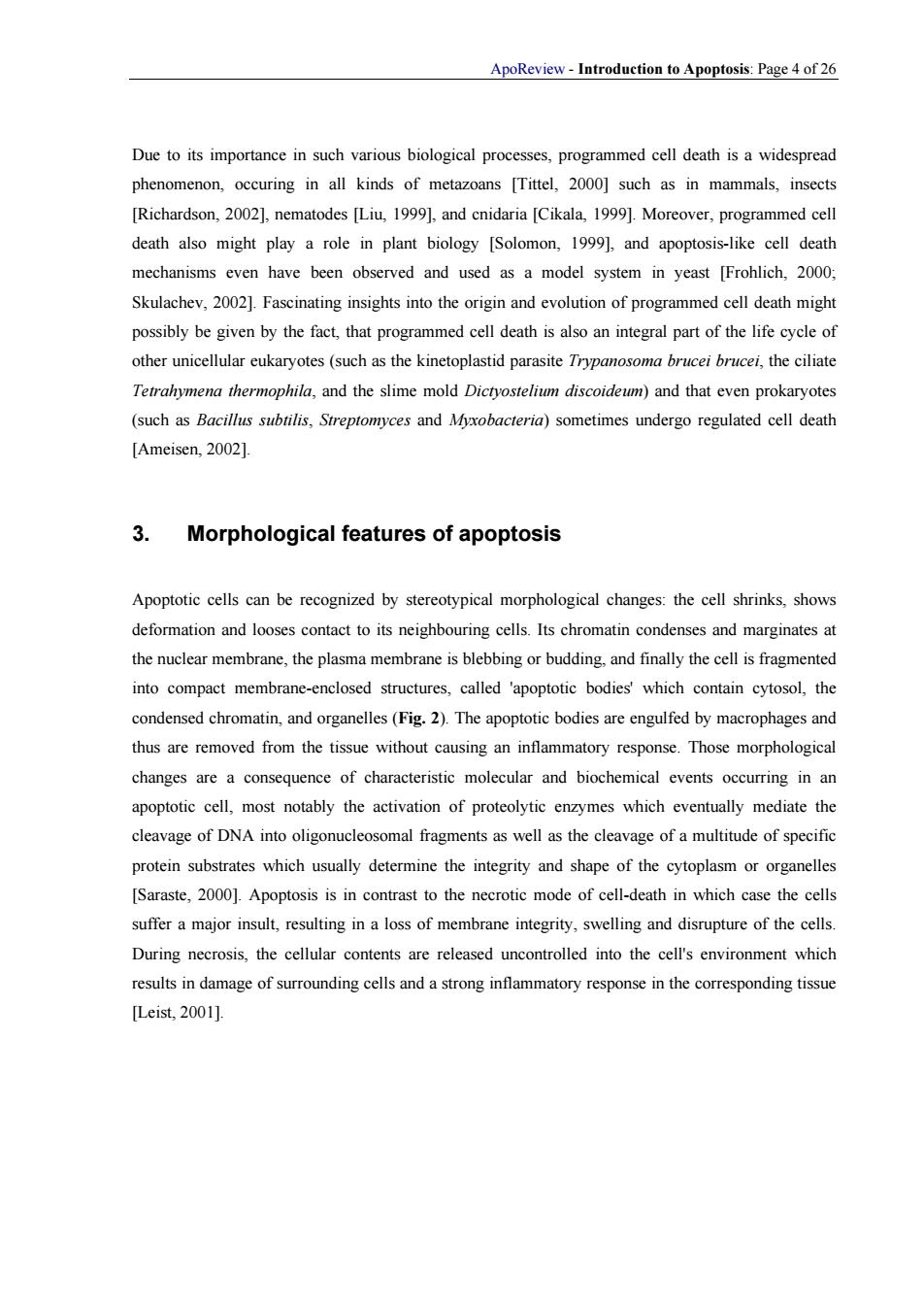正在加载图片...

ApoReview-Introduction to Apoptosis:Page 4 of26 Due to its importance in such various biological processes,programmed cell death is a widespread phenomenon,occuring in all kinds of metazoans [Tittel,2000]such as in mammals,insects [Richardson,2002]nematodes [Liu,199and cnidaria [Cikala,199].Moreover,programmed cell death also might play a role in plant biology [Solomon,1999],and apoptosis-like cell death mechanisms even have been observed and used as a model system in yeast [Frohlich.2000. Skulachev,2002].Fascinating insights into the origin and evolution of programmed cell death might possibly be given by the fact,that programmed cell death is also an integral part of the life cycle of other unicellular eukaryotes (such as the kinetoplastid parasite Trypanosoma brucei brucei,the ciliate Tetrahymena thermophila.and the slime mold Dictvostelium discoideum)and that even prokaryotes (such as Bacillus subrilis,Streptomyces and Myxobacteria)sometimes undergo regulated cell death [Ameisen,20021 3. Morphological features of apoptosis Apoptotic cells can be recognized by stereotypical morphological changes:the cell shrinks,shows deformation and looses contact to its neighbouring cells.Its chromatin condenses and marginates at the nuclear membrane,the plasma membrane is blebbing or budding.and finally the cell is fragmented into compact membrane-enclosed structures,called 'apoptotic bodies which contain cytosol,the condensed chromatin,and organelles(Fig.2).The apoptotic bodies are engulfed by macrophages and thus are removed from the tissue without causing an inflammatory response.Those morphological changes are a consequence of characteristic molecular and biochemical events occurring in an apoptotic cell,most notably the activation of proteolytic enzymes which eventually mediate the cleavage of DNA into oligonucleosomal fragments as well as the cleavage of a multitude of specific protein substrates which usually determine the integrity and shape of the cytoplasm or organelles [Saraste,2000].Apoptosis is in contrast to the necrotic mode of cell-death in which ease the cells suffer a major insult,resulting in a loss of membrane integrity.swelling and disrupture of the cells. During necrosis,the cellular contents are released uncontrolled into the cell's environment which results in damage of surrounding cells and a strong inflammatory response in the corresponding tissue [Leist.20011. ApoReview - Introduction to Apoptosis: Page 4 of 26 Due to its importance in such various biological processes, programmed cell death is a widespread phenomenon, occuring in all kinds of metazoans [Tittel, 2000] such as in mammals, insects [Richardson, 2002], nematodes [Liu, 1999], and cnidaria [Cikala, 1999]. Moreover, programmed cell death also might play a role in plant biology [Solomon, 1999], and apoptosis-like cell death mechanisms even have been observed and used as a model system in yeast [Frohlich, 2000; Skulachev, 2002]. Fascinating insights into the origin and evolution of programmed cell death might possibly be given by the fact, that programmed cell death is also an integral part of the life cycle of other unicellular eukaryotes (such as the kinetoplastid parasite Trypanosoma brucei brucei, the ciliate Tetrahymena thermophila, and the slime mold Dictyostelium discoideum) and that even prokaryotes (such as Bacillus subtilis, Streptomyces and Myxobacteria) sometimes undergo regulated cell death [Ameisen, 2002]. 3. Morphological features of apoptosis Apoptotic cells can be recognized by stereotypical morphological changes: the cell shrinks, shows deformation and looses contact to its neighbouring cells. Its chromatin condenses and marginates at the nuclear membrane, the plasma membrane is blebbing or budding, and finally the cell is fragmented into compact membrane-enclosed structures, called 'apoptotic bodies' which contain cytosol, the condensed chromatin, and organelles (Fig. 2). The apoptotic bodies are engulfed by macrophages and thus are removed from the tissue without causing an inflammatory response. Those morphological changes are a consequence of characteristic molecular and biochemical events occurring in an apoptotic cell, most notably the activation of proteolytic enzymes which eventually mediate the cleavage of DNA into oligonucleosomal fragments as well as the cleavage of a multitude of specific protein substrates which usually determine the integrity and shape of the cytoplasm or organelles [Saraste, 2000]. Apoptosis is in contrast to the necrotic mode of cell-death in which case the cells suffer a major insult, resulting in a loss of membrane integrity, swelling and disrupture of the cells. During necrosis, the cellular contents are released uncontrolled into the cell's environment which results in damage of surrounding cells and a strong inflammatory response in the corresponding tissue [Leist, 2001]